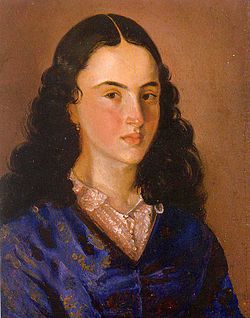
Back المرأة في كولومبيا Arabic কলম্বিয়াৰ নাৰী Assamese Derechos de las mujeres en Colombia Spanish زنان در کلمبیا Persian Mulleres en Colombia Galician കൊളംബിയയിലെ സ്ത്രീകൾ Malayalam Женщины в Колумбии Russian
 Policarpa Salavarrieta, heroine of the Colombian Independence Movement. Portrait by Jose Maria Espinosa, 1855 | |
| General Statistics | |
|---|---|
| Maternal mortality (per 100,000) | 92 (2010) |
| Women in parliament | 20% (2014)[1] |
| Women over 25 with secondary education | 56.9% (2012) |
| Women in labour force | 60% (2014)[2] |
| Gender Inequality Index[3] | |
| Value | 0.424 (2021) |
| Rank | 102nd out of 191 |
| Global Gender Gap Index[4] | |
| Value | 0.710 (2022) |
| Rank | 75th out of 146 |
| Rights |
|---|
 |
| Theoretical distinctions |
| Human rights |
| Rights by beneficiary |
| Other groups of rights |
|
| Part of a series on |
| Women in society |
|---|
 |
As established in the Colombian Constitution of 1991, women in Colombia have the right to bodily integrity and autonomy; to vote (see also: Elections in Colombia); to hold public office; to work; to fair wages or equal pay; to own property; to receive an education; to serve in the military in certain duties, but are excluded from combat arms units; to enter into legal contracts; and to have marital, parental and religious rights. Women's rights in Colombia have been gradually developing since the early 20th Century.[5]
- ^ "Proportion of seats held by women in national parliaments (%) | Data".
- ^ "Labor force participation rate, female (% of female population ages 15-64) (Modeled ILO estimate) | Data".
- ^ "Human Development Report 2021/2022" (PDF). HUMAN DEVELOPMENT REPORTS. Retrieved 9 December 2022.
- ^ "Global Gender Gap Report 2022" (PDF). World Economic Forum. Retrieved 23 February 2023.
- ^ (in Spanish) University of Vigo; political rights and citizenship of Colombian women
© MMXXIII Rich X Search. We shall prevail. All rights reserved. Rich X Search